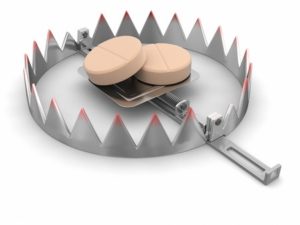Chantix Tug-of-War
On May 18, 2008, George MacDonald was at Fort Benning Georgia. George and his identical twin brother James had successfully completed Infantry Training and the Airborne Course at Fort Benning. They had also been selected for the U.S. Military Academy Preparatory School. George was a one-time Eagle Scout. He got up from his bunk to do some laundry and slipped a knife into his pocket. He approached the bunk where Rick Bulmer, who he did not know, was sleeping. Then he stabbed and slashed Rick more than 50 times. A month before, MacDonald had been prescribed Chantix by an Army doctor to help him stop smoking.
Nine hours after the killing, Macdonald wrote: “I snapped and didn’t like it … I was stretched and it made me crazy.” The military judge refused to allow an involuntary intoxication defense and quashed a subpoena issued to Pfizer by MacDonald’s lawyer. Within a month of the judge’s decision, the FDA imposed a black box warning on Chantix. “Within weeks of the military trial judge’s decision in 2009 to quash the subpoena, Pfizer began getting hit with civil lawsuits claiming Chantix had caused suicides, suicide attempts or other neuropsychiatric problems.” MacDonald was convicted of premeditated murder in 2009 and sentenced to life without parole.
The U.S. Court of appeals for the Armed Forces overturned MacDonald’s conviction saying the trial judge had erred in not allowing the involuntary intoxication defense. MacDonald agreed to plead guilty to the unpremeditated murder of Rick Bulmer and his sentence was reduced to 45 years. Bulmer’s family was outraged, according to Tom Jackman writing for The Washington Post. “’It’s a mindblower, and we don’t understand it,’ said Bulmer’s mother, Wendy Smith. ‘He cold-bloodedly killed my son. He knew what he was doing and … he should take his punishment.’”
In a 2010 clemency request for his brother, James wrote that he remarked to his brother that life had started to feel like a video game, where he was disconnected from his body. James had also been prescribed Chantix. George agreed he felt the same way. James said, “I remember the two of us waking up at night having really weird dreams, scary dreams.” In 2013, James killed himself by jumping off of a 19-story building. His sister said he never got over his grief over his brother’s ordeal. You can read more about the MacDonald case here, here and here on McClatchyDC.
George MacDonald is not alone is claiming that his use of Chantix led to violent acts. In the beginning of August 2016, a Maryland man was found not criminally responsible for shooting his wife in the neck because he was “involuntarily intoxicated” from Chantix. A woman who was taking medication for other reasons used Chantix briefly in 2007. She got her daughter off to school and the next thing she remembered was standing in her kitchen in a puddle of blood. Six hours has passed during which she had used a kitchen knife to cut her left arm. Federal prosecutors dropped charges against a man who “was extremely psychotic and disorganized” aboard a United Airlines flight because of a “Chantix-induced psychotic disorder.”
Al Jazeera reported that Chantix has been linked to 544 suicides and 1,869 attempted suicides. As a result of a report issued by the Institute for Safe Medication Practices that said the organization had “immediate safety concerns” about individuals operating aircraft, trains buses and other vehicles who were using Chantix, the FAA and Defense Department banned Chantix use among pilots and air traffic controllers.
Eventually some 2,700 former Chantix users sued Pfizer in 2011. Pfizer began to settle with the lawyers representing the mass of civil lawsuits at a cost of $299 million through the first quarter of 2013. Pfizer said the settlement would allow the company to focus on the benefits of the drug. This strategy has been the typical way pharmaceutical companies try to settle lawsuits they aren’t sure they can win. It keeps subpoenaed records out of the hands of the public and other individuals who may want to sue them as well. And it prevents the articulation of a coherent argument about the association between a specific drug and an adverse event from being made in the public square. It enables the pharmaceutical continue to assert as Pfizer did in a statement to McClatchy: “There is no reliable scientific evidence that Chantix causes serious neuropsychiatric events.”
Chantix is approved for use in more than 100 countries and has been prescribed to over 20 million patients worldwide, including more than 10 million in the United States.
Then in April of 2016 the results of a study on more than 8,100 people were published in Lancet. The study had been ordered by the FDA because of the ongoing reports of neuropsychiatric adverse events with Pfizer’s Chantix and GlaxoSmithKline’s Zyban. “The study did not show a significant increase in neuropsychiatric adverse events attributable to varenicline or bupropion relative to nicotine patch or placebo.” However, the funding for the study was from Pfizer and GlaxoSmithKline.
Writing for STAT News, Ed Silverman quoted the study authors as saying: “The findings show that it is highly unlikely that (the medicines) contribute to neuropsychiatric adverse events.” The results of the EAGLES study, which the Lancet article was reporting, were processed by Clinical Trials.gov on September 1, 2016, and are available here: Clinical Trials.gov Identifier: NCT01456936.
The results may be a boon for Pfizer, which has struggled for a decade to transform Chantix into a blockbuster product, but instead has encountered negative publicity, expensive litigation, and stalled sales.
Pfizer plans to ask the FDA to remove the black box warning from Chantix. A company spokesperson said: “Available scientific evidence concerning neuropsychiatric events in patients attempting to quit smoking does not support a boxed warning in the Chantix label.” The FDA will review the findings along with additional scientific evidence as they continue to evaluate the issue.
Thomas Moore, a senior scientist with the Institute for Safe Medical Practices, said it would be a mistake to claim the study proves that severe psychiatric side effects don’t occur with Chantix. Because it was a manufacturer-sponsored study done in 140 different centers in 16 countries, Moore suggested it be independently reviewed. Early onset cases of psychosis, aggression and suicidal behaviors have been observed with Chantix by regulators in many countries, “far outnumbering those reported for other smoking treatments.”
With eight different treatment arms, the number of patients in each may not be enough to capture the severe psychiatric side effects for which the drug is known. The study’s severity assessments were subjective judgments, and the combined endpoint included many psychiatric side effects that Chantix is not suspected of causing.
The criticism by Moore has some legitimacy. Here is a study that found Chantix (varenicline) was no better than NRT (nicotine patch) and C-NRT (nicotine patch and lozenge) with regard to abstinence. “However it is notable that there were significant adverse events of varenicline compared to NRT (e.g. nausea, insomnia, sleepiness) and C-NRT compared to NRT (indigestion, nausea, mouth problems and hiccups).” The website RxISK described several examples of “Chantix and Violence” that were originally reported in the FDA database for adverse drug events.
MacDonald’s case was one of the ones reported on RxISK. There it was reported that George and his twin brother (James) enlisted in the Army were selected for an appointment to the United States Military Academy Preparatory School. The reported adverse effects experienced by MacDonald included: nightmares, psychosis, homicidal ideation, senseless act, and homicide. The Case report said:
Appellant had been experiencing “new and strange thoughts” including a “person [was] telling me . . . dangerous things that arent [sic] me.” These included violent thoughts of killing someone. On May 18, 2008, one month after the Army doctor prescribed Chantix, Appellant fatally attacked Private (PVT) Bulmer while he was sleeping, stabbing him to death. Prior to this attack, Appellant did not know nor had he ever interacted with PVT Bulmer.
The other cases reported suicidal and homicidal ideation, a suicide attempt, uncontrolled aggression/anger, and senseless violence. What follows are two more of the case reports on RxISK. Thomas Moore sent this information to RxISK.
By the third day of taking Chantix I was completely out of control. I woke my boyfriend up in the middle of the night and started physically beating him. I contemplated suicide about 5 times a day and contemplated homicide about 3 times a day. On Saturday while at home she got into a verbal argument with her mom over a minor issue and reports now that she was ‘totally out of hand’ and she was unable to control her impulses and was yelling and screaming and crying. She acutely became suicidal and also became homicidal threatening her mother with a shotgun. Her mother fled the house and called police. She locked herself in the bathroom and eventually calmed down.
In October of 2014, five nonprofit consumer organizations (Consumer Reports, Institute for Safe Medication Practices, National Center for Health Research, National Physicians Alliance, and Public Citizen) petitioned the FDA to require that the Chantix have boxed warnings clearly describing adverse psychiatric adverse events: suicidal behaviors, aggression/violence, psychosis, and depression. Additional risks with Chantix the petition noted were: sudden blackouts, seizures and impaired vision. I hope and expect they will again protest when Pfizer formally requests that the FDA drop its black box warning for Chantix.
For a previous article about the tug-of-war over problems with Chantix, see “Smoke and Mirrors.”




